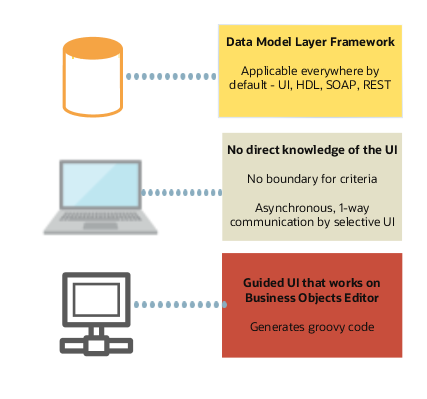Overview of Autocomplete Rules
The Human Capital Management (HCM) suite of products has several configurable and optional components that you can configure as per your business needs.
With the Transaction Design Studio, Oracle delivered a capability to tailor the user experience in terms of fields and sections to show, hide, or mandate based on the action criteria. Autocomplete Rules, which is also a part of the HCM Experience Design Studio takes the user experience to the next level by allowing customers to define very specific criteria for defaulting and validation across its suite of products. The need for customer-specific defaulting and validation arises because of these reasons:
-
The underlying data model that supports the application is the same for all customers.
-
Every business is unique and has its own requirements to enforce rules governing implementation of the application.
Using Autocomplete Rules, you can default values and validate info entered in fields in the supported mobile-responsive flows only.
Autocomplete Rules Tool
Autocomplete = Auto populate (Default) + Auto correct (Validate)
The major drivers for defaulting or validation are business processes, localizations, company policies, and statutory requirements. The implementation is driven by rules authored in a logical scripting environment, which can be configured according to your requirements.
Autocomplete Rules is a Data Model Layer Extensibility framework unlike the Transaction Design Studio or Page Composer, which are both user interface (UI) driven. Autocomplete Rules has no direct knowledge of the UI and is driven by the state of values in various fields of different objects. The tool leverages the advantages of the Data Model Layer Extensibility framework. The framework enables you to use different criteria to default or validate, anywhere in a guided flow or static setup data.

You author rules using guided logical coding or scripting. Autocomplete then generates a more complex code for the Applications Data Framework (ADF) Business Objects Editor framework to interpret and execute the rules. The performance and behavior of a custom rule is similar to an out-of-the-box Oracle-delivered rule.
Defaulting Capabilities
You can specify your own default values for various fields..The criteria is either visible or hidden values in other fields in the same section or in previously accessed sections. These values may be "in-flight" as the transaction isn't submitted yet, or static values such as the previous state of assignment before the current change. The criteria fields can be any of the commonly used Workforce Structure setup objects. predefined, or extensible flexfields.The default value appears as an automatically filled out value based on your specific rule in the UI.
Validation Capabilities
You can leverage the extensive criteria available and relevant to the current context while validating fields. A validation can be a warning message before proceeding or an error message. These messages appear in the same window along with the out-of-the-box error messages.